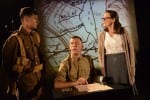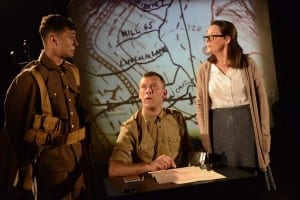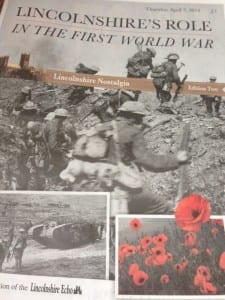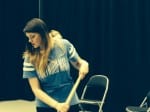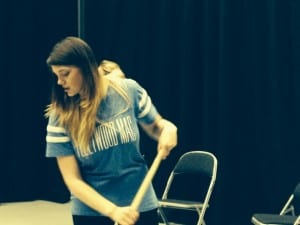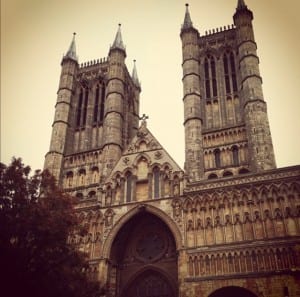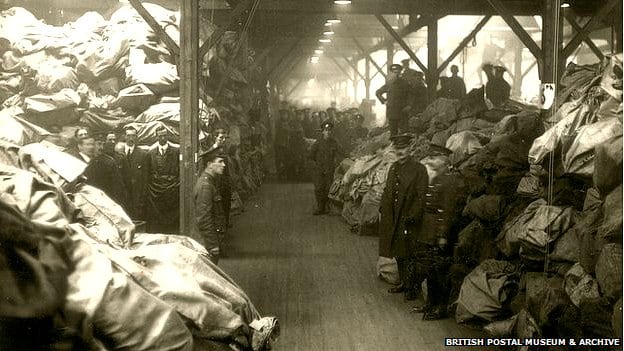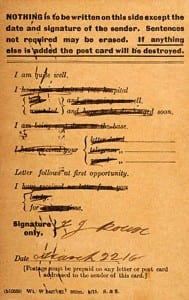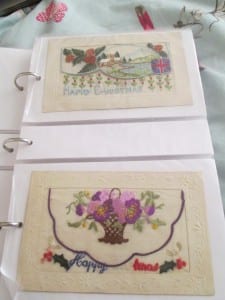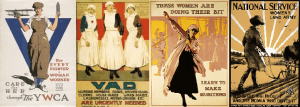Here is my last blog post for ‘Sincerely Yours’. I hope that you have all enjoyed reading about our process and our performance. Thanks for all the support.
Author Archives: Jennie Chapman
Why World War One? A reflection.
Why did we choose to do a piece on WWI, you might ask? Well the obvious answer might be that this year is the start of the centenary commemoration for WWI. Another answer is that we are University of Lincoln students and Lincolnshire is renowned for its involvement in the war with the first tanks being built just down the road from the campus and its prominence in aircraft and aerial combat. The final answer we could give is that we hear a lot about trench warfare and the soldiers on the front line during the war but we rarely hear about those on the Home Front, doing their bit for the war; especially women.
As we have journeyed through the past few months, we have encountered many more projects that are taking place in the near future for the centenary of WWI. This includes events at museums and archives, such as the Lincolnshire Life Museum and also performances in the local area as well as a National scale. For example The Second Minute was recently performed at The Terry O’Toole Theatre which a few of the birds went to see. It is a play written by Andy Barrett who has taken letters from archives of the Sherwood Foresters regiment during WWI, which resonates strongly with our own performance as he uses the soldiers’ real words You can hear all about The Second Minute from Louise, the link is below.
As well as other projects taking place on a local scale, with ‘Sincerely Yours’ we have tried to connect to the audience on a personal level. Not only with the letters of Harry Butt and Billy Lounds, but with our own relatives. Lauren Simpson, Emily, Louise and Charlotte have all found information, stories and artefacts that have been included throughout the process and some in the final performance. After our work in progress we were told that the personal side of our performance should be acknowledged even more in order for the audience to connect with the piece. In order to do this we made sure that the audience knew that some of the voices, words and footage were from our relatives, we also connected through with with our programmes for the show. Each programme had a letter from one of us from the process of the piece, any letter dated between January and May, we also styled the programme in a postcard to symbolise the silk postcards many families received from soldiers during the war.
Also on a personal and local scale, many of the letters we use in the performance are from soldiers Harry Butt and Billy Lounds who were local boys who went to France leaving their sweethearts behind. Whilst reading the letters there were references to places in Lincoln like Barclay’s Bank, the Arboretum and the Cathedral. Places that we have walked past or visited over the past three years, sometimes everyday. One letter that I strongly connected to was Billy’s letter from the 27th May 1917, where he talks of the cathedral. I’ve often visited the cathedral to get away from work, stress, to think or just because I wanted to go. So to read his letter and to have him speak of the cathedral in such a way, it makes you admire what is around you, especially when you think of where he was at the time of writing it.
Link to blog posts:
Works Cited:
.Nottingham Playhouse (2014) The Second Minute. [online] Nottingham: Nottingham Playhouse. Available from: http://www.nottinghamplayhouse.co.uk/whats-on/other/the-second-minute/. [Accessed on 25th May 2014]
.Pullen, R. (2014) Our Florence, the girl who just wanted to do her bit for the war. The Lincolnshire Echo, 3rd April, 10.
Pullen, R. (2014) The Tank- Made in Lincoln. The Lincolnshire Echo. 3rd April, 8.
.The Lincolnshire Echo (2014) Women at War. 3rd April, 28.
.The Lincolnshire Echo (2014) Aviation- The Beginning. 3rd April. 18.
A Day In The Life Of A Performer/ Dramaturg
Dear Reader,
As a disclaimer I will say that this was not my routine everyday of the process as it varied very much with what was needed and other work but this is an example of a few of my days during the process just so you get an idea. During the process I’ve had to balance the responsibilities of a dramaturg as well as a performer, so here you are…
Well, I begin the day by obviously waking up around 9am, get ready and get some breakfast. I’m useless if I don’t have breakfast so I need my cereal!
Then I get all my stuff ready for me to head off to the Archives to copy up the letters from Harry Butt and other letters that we’ve been looking at. As part of my responsibility as a dramaturg, I have to collect the letters and all the research that we have done towards the show.
I’m normally there for about three hours, which means a lot of writing and aching wrist. But a lot gets done for the purpose of the show. We’re using the letters as part of the aesthetics of the piece as well as using them within the performance.
After the Archives, it’s normally about 2pm at which point I head off home to collect all of my things for rehearsals which start at 4pm. Depending on what we are doing in rehearsals that day, it may require a selection of our props from tap shoes to sheets to brooms (which was the majority of the time!) to my ipod and headphones. Today we are looking at the ‘Somewhere in France Scene’ so I need my trusty broom.
I head to rehearsals just before 4pm and we wait for everyone to show up before going to the room. We start with one of the many warm ups we have encountered over the last few months to get ourselves motivated and energised. Rehearsals require our concentration, imagination and creative side to put together the scene as it has been one of the harder scenes to stage but it is coming along nicely.
We normally finish our rehearsals for the day at about 10 to 6 in order for us to write a letter and share them with each other. After departing, we all fly back to our nests (figuratively) and get on with any work we need to sort out for theatre company or any other work. As well as feed ourselves and relax a little, but mainly work!
All in all that is my day.
Sincerely yours,
Jennie
xxx
Verbatim Theatre: ‘The Last Journey’
In the show we have composed several scenes where we have used our interviews with relatives and local residents as verbatim. The purpose of verbatim has been described by Hammond as follows: “Instead of adapting or repackaging experiences or observations within a fictional dramatic situation, a verbatim play acknowledges, and often draws attention to, its roots in real life” (2008, p1). The idea being that you display the interviewee through the actor by imitating the person’s pauses, inflections in their voice and use the precise words that have been recorded. The idea of verbatim is to present a sense of authenticity because “if you go out and collect evidence about people’s way of life, things are revealed to you which are completely extraordinary that you don’t see coming”(National Theatre Discover, 2014); a truth that can be presented to an audience.
Some regard verbatim as a form of theatre however, as Hammond and Steward point out, it is a technique within theatre (2008, p1). This is due to the nature of verbatim as a source of information which can then be configured into a narrative creating a drama. The verbatim may be edited for a particular section of the interview or can be stylistically edited through the use of other sounds or rhythms. Within our show Lauren has devised a few ways in which we present the verbatim. Some pieces are the original recordings, some are simply spoken to the audience (this is the common feature for the verbatim from the letters we are using) and also we have taken inspiration from Dan Canham and Stillhouse’s performance with using audio devices like an Ipod where we listen to the recorded verbatim and speak whilst listening .
The piece of verbatim that was designated to me was by a lady from the Eastholme Care Centre. We came to name this piece ‘The Last Journey’. I worked very closely with Lauren to decipher the rhythm and pace of the verbatim. We soon realised that the piece was by far the fastest pace out of all the verbatim and so it took me a while to grasp everything the lady said. One piece of advice that Dan Canham gave us when using verbatim was to treat the verbatim as a rhythm. So once I had practised speaking with the lady and the pace, Lauren helped me break the piece down into sections where there were pauses in the speech or slight changes in pace. This helped greatly with translating the inflections in the lady’s voice in my own voice for the performance. Another note Dan emphasised was to not to learn the verbatim like lines from a play, the idea being that we embody the voice of the person, it was natural occurrence and not forced.
Speaking someone else’s words at first can seem very strange. I found that to begin with, I would just say the words in my own voice. It wouldn’t have much tone or emotion involved and very dull, hearing myself anyway! Gradually you have to forget about what your own voice sounds like and truly listen to the other person’s to be able understand what it is you’re trying to do with the verbatim. Every detail in the track matters; the pauses, the changes, the accent, the inflections. That is what makes the person and that is what you need to be able to portray the person to the audience. The person is manifested/transferred through you to the audience. Below is the audio track of ‘The Last Journey’ verbatim that I will be performing in the show and also a couple of links to Lauren’s posts on how she directed the verbatim in ‘Sincerely Yours’.
Links to Lauren Kirby’s (Director) blogs on Verbatim:
Works Cited:
Hammond, W. and Steward D. (eds.) (2008) Verbatim Verbatim: Contemporary Documentary Theatre, London: Oberon Books.
National Theatre Discover (2014) An Introduction to Verbatim Theatre [online video] Available from: https://www.youtube.com/watch?v=ui3k1wT2yeM, [Accessed 5th May 2014].
National Theatre Discover (2014) The Ethics of Verbatim Theatre [online video] Available from: https://www.youtube.com/watch?v=39JSv-n_W5U, [Accessed 5th May 2014].
The Ripples Grow
From the casting of our pebble a few months back, the ripples have grown. As our ideas have developed, our confidence in ourselves and as a company have also strengthened. With this ever growing confidence with our work, we have seen refinement to some of our original ideas and also used influences from other professional such as Michael Pinchbeck’s The Trilogy and Still House’s Ours Was the Fen Country plus our own research to create original and exciting new work.
We have stuck with the idea of presenting a Documentary piece of theatre as it seemed appropriate for our desired subject we were looking at, World War One, rather than producing a straight play. It has also allowed us the liberty to spread our wings, as it were, and discover the multitude of information and resources about World War One and utilise it to our own ability and effect. The main purpose and point in our manifesto is to create real theatre.
“We are committed to creating REAL theatre. Honest theatre. Truthful theatre. Theatre that uses real people’s voices. We want to give history the chance to speak again” (Manifesto)
With the chosen path of our work we have stayed true to this as much as possible. All of the text we have used so far, mainly the letters we found, have not been edited with embellishments or alterations. We have taken the raw text and used other elements such as music and movement to stylise the presentation of the texts. The influence of verbatim theatre came from Dan Canham’s performance Ours Was the Fen Country, which used real people’s stories and voices to create a representation and atmosphere of the Fens. This is what we are trying to achieve with finding stories and letters from World War One in order for the audience to gain an insight into Lincolnshire’s place in World War One and also some stories that are personal to members of our company.
Links to previous blog posts:
Works Cited:
- Birds Eye View Theatre Company (2014) Manifesto [online] Lincoln: University of Lincoln Blogs and Social Network. Available from: https://birdseyeviewtheatre.blogs.lincoln.ac.uk/sample-page/manifesto/, [Accessed on 14th April 2014].
- Pinchbeck, M. (2014) The Trilogy. [performance] Michael Pinchbeck (dir.) Lincoln: Lincoln Performing Arts Centre, 30th January.
- Stillhouse (2014) Ours Was The Fen Country. [performance] Dan Canham (dir.) Lincoln: Lincoln Performing Arts Centre, 6th Feb.
Letters: Role of the Post Office in World War One
The Post Office was a crucial part of Britain’s communications and war effort during the Great War (The British Postal Museum and Archive, 2014). The Post Office were not only responsible for the communications on the Front Line but also between the Front Line and home. At the London Home Depot there were 2,500 women employees alone to sort through letters and parcels and over the first two years of the war, 35,000 women were drafted in to work for the Post Office. 12.5 million letters were sent every week and a total of 2 billion letters and 114 million parcels were sent during the war.
We have taken a great interest in letters for our performance hence our title ‘Sincerely Yours’ After visiting the Museum of Lincolnshire Life and finding many letters from Billy Lounds, we were intrigued to see whether we could find any others. With a trip to the Lincolnshire Archives, Ellie, Charlotte and Louise encountered another lot of letters from Private Harry Butt. We started to compile the letters that we had found and after reading many of them we realised that there were several references to the local area of Lincoln. I’ll also admit that a fair few of us have fallen in love with either Harry or Billy or both!
As lovely as it was to read these letters and the significance of these letters, it dawned on us that we were reading personal, private letters. It is a sensitive subject to explore, all these letters to the men’s sweethearts and mothers so we must be careful with how we use them. As well as actual letters there were many other forms of letters that we found such as telegrams, field postcards and also beautifully detailed silk postcards.
We are possibly going to use some of these letters we have found within out final piece as we have been conducting several experiments with what we could do for example. We responded as Dora to a letter from Billy. It was a good exercise as, although we are not trying to be these women, it helped us think about the possible emotions and thoughts these would have had when receiving these letters. We have now taken inspiration from the silk postcards to create our flyers for the performance. We are creating our own design in a similar style to the postcards we have seen and will convey our piece to its receiver.
Works Cited:
BBC (2014) World War One: How did 12 million letters a week reach soldiers? [online] London: BBC. Available from: http://www.bbc.co.uk/news/magazine-25934407 [Accessed 15th March 2014]
BBC (2014) iWonder World War One: How did 12 million letters a week reach soldiers? [online] London:BBC. Available from: http://www.bbc.co.uk/guides/zqtmyrd [Accessed 15th March 2014]
The British Postal Museum & Archive (2014) The Post Office and the First World War [online] Available from: http://www.postalheritage.org.uk/page/firstworldwar [Accessed 15th March 2014]
The British Postal Museum & Archive (2014) The Post Office At War [online] Available from: http://www.postalheritage.org.uk/page/peoplespost-war [Accessed 15th March 2014]
Women in WW1 and Our Performance
We, as a company, have now established that our performance will be about the women of WWI. In order for us to follow through with our manifesto and ideas as a company, a lot of research will be required. As the company’s dramaturg it is my job to not only research as well as the other birds but to double check whether the material is appropriate for our performance. By this I mean, historically and conceptually appropriate.
It would seem ideal then for us to start with the roles women took on when the war came about. Many women did work before the war began, however, this was the first time where there was mass employment for all women. Half a million women worked for the first time during the war as well as over one million volunteers (BBC, 2014). Much of the work undertaken by women, over 600,000, during this time were roles that had previously been dominated by males especially those within industry (Brosnan, 2014).
Women’s took up jobs in policing, working the land, public transport, the post office, nursing, factories, the Armed services, the Government positions, clerks in businesses and many other. Many women went to work in the munitions factories, a job that was highly dangerous. The munitionettes produced 80% of the weapons and shells for the British Army and were exposed daily to the poisonous substances without strict safety measures (Martin, 2009). They became known as the ‘canary girls’ due to the yellowing of their skin dealing with sulphur contained within the shells (ibid).
With the knowledge of the munitionettes, we decided that this would be a part of our performance somehow, We wanted to show that not only were the men fighting on the front line were risking their lives for their country but also women back home were also risking their lives to support their boys and war effort. We began to develop a choreographed sequence to show the monotony of the factory work, the character of these brave women and the demand for the front line. Below is some of the improvisation we did, to start developing the scene:
Another way in which we are portraying the women in WWI in our piece is through the use of verbatim inspired by Dan Canham and Stillhouse’s performance Ours Was the Fen Country. Both Lauren Simpson and Louise have researched their family’s involvement in the war. Both have interviewed relatives and discovered more articles that we can potentially use in the performance. We are hoping that we can use their interviews as part of the verbatim as both talk of women in different areas of work including the cotton mills and munition factories and also working as a butler. We don’t wish to act these people’s voices but we want to transpire these voices through us to the audience as Dan Canham explains”…we’ve been playing a lot with people’s voices almost as if they’re not with us, so placing people’s voices in little speakers or having their voices disembodies, what it means to embody their voices, almost as if we’re kind of bringing them into the room making them visible, making them embodied because they’re not with us literally” (Stillhouse, 2013).
We are also going to, hopefully, use the letters we have found at the Museum of Lincolnshire Life and the Lincolnshire Archives from Billy Lounds and Harry Butt. We have researched both Dora and Alice, the two recipients of their letters, and have found some details about them. However, again we do not want to act as these women reading these letters as we don’t know who these women were or what they were thinking when they did receive the letters. In order for us to use these letters, we will have to negotiate a way in which to speak these letters without fabrication.
Works Cited:
. BBC (2014) iWonder: What Did World War One Really Do For Women? [online] London:BBC. Available from: http://www.bbc.co.uk/guides/z9bf9j6. [Accessed February 2014].
.Brosnan, M. (2014) The Women War Workers of the North West. [online] London: IWM. Available from: http://www.iwm.org.uk/history/the-women-war-workers-of-the-north-west. [Accesssed 10th February 2014].
Imperial War Museum (2014) Women’s Services in the First World War. [online] London: IWM. Available from: http://www.iwm.org.uk/history/womens-services-in-the-first-world-war. [Accessed 10th February 2014].
.Martin, S. (2009) Women and WWI- Women in the Workforce: Temporary Men. [online] Available from: http://www.firstworldwar.com/features/womenww1_four.htm [Accessed 10th February 2014].
Stillhouse (2013) Ours Was The Fen Country- Research and Development, May 2012. [podcast] 2013. Available from: http://vimeo.com/45147781. [Accessed 20th February 2014].
